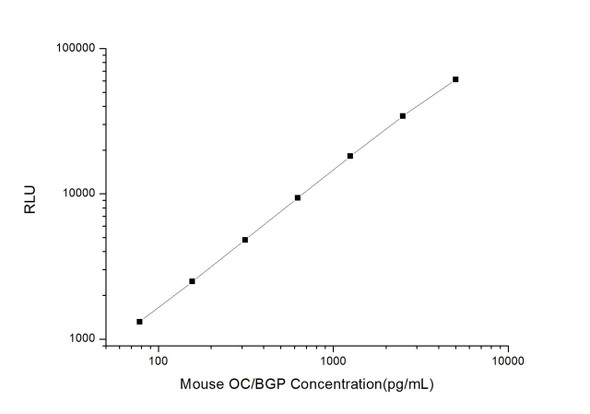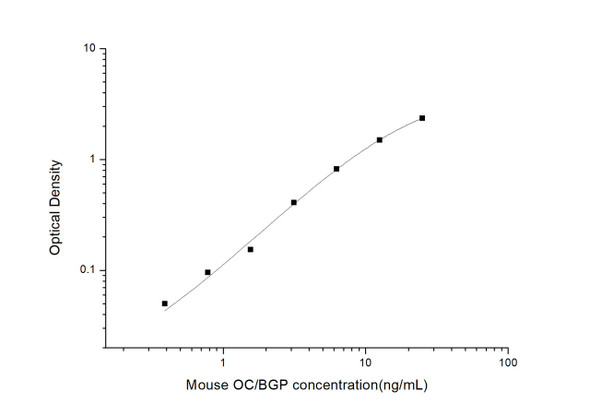Rat Signaling ELISA Kits 2
Rat OC/BGP (Osteocalcin) CLIA Kit (RTES00145)
- SKU:
- RTES00145
- Product Type:
- ELISA Kit
- ELISA Type:
- CLIA Kit
- Size:
- 96 Assays
- Sensitivity:
- 0.09ng/mL
- Range:
- 0.16-10ng/mL
- ELISA Type:
- Sandwich
- Synonyms:
- BGLAP, OT, Bone Gamma-carboxyglutamate Protein, Bone Gla Protein
- Reactivity:
- Rat
- Sample Type:
- Serum, plasma and other biological fluids
- Research Area:
- Signal Transduction
Description
| Assay type: | Sandwich |
| Format: | 96T |
| Assay time: | 4.5h |
| Reactivity: | Rat |
| Detection method: | Chemiluminescence |
| Detection range: | 0.16-10 ng/mL |
| Sensitivity: | 0.09 ng/mL |
| Sample volume: | 100µL |
| Sample type: | Serum, plasma and other biological fluids |
| Repeatability: | CV < 15% |
| Specificity: | This kit recognizes Rat OC/BGP in samples. No significant cross-reactivity or interference between Rat OC/BGP and analogues was observed. |
This kit uses Sandwich-CLIA as the method. The micro CLIA plate provided in this kit has been pre-coated with an antibody specific to Rat OC/BGP. Standards or samples are added to the appropriate micro CLIA plate wells and combined with the specific antibody. Then a biotinylated detection antibody specific for Rat OC/BGP and Avidin-Horseradish Peroxidase (HRP) conjugate are added to each micro plate well successively and incubated. Free components are washed away. The substrate solution is added to each well. Only those wells that contain Rat OC/BGP, biotinylated detection antibody and Avidin-HRP conjugate will appear fluorescence. The Relative light unit (RLU) value is measured spectrophotometrically by the Chemiluminescence immunoassay analyzer. The RLU value is positively associated with the concentration of Rat OC/BGP. The concentration of Rat OC/BGP in the samples can be calculated by comparing the RLU of the samples to the standard curve.
| UniProt Protein Function: | osteocalcin: Constitutes 1-2% of the total bone protein. It binds strongly to apatite and calcium. Belongs to the osteocalcin/matrix Gla protein family. |
| UniProt Protein Details: | Protein type:Cell development/differentiation; Secreted; Secreted, signal peptide Chromosomal Location of Human Ortholog: 2q34 Cellular Component: cell projection; cytoplasm; dendrite; extracellular region; extracellular space; Golgi apparatus; perikaryon; rough endoplasmic reticulum; vesicle Molecular Function:calcium ion binding; structural constituent of bone Biological Process: aging; biomineral formation; cell aging; odontogenesis; ossification; osteoblast development; osteoblast differentiation; regulation of bone mineralization; response to activity; response to drug; response to estrogen; response to ethanol; response to glucocorticoid stimulus; response to gravity; response to hydroxyisoflavone; response to inorganic substance; response to mechanical stimulus; response to nutrient levels; response to organic cyclic compound; response to testosterone stimulus; response to vitamin D; response to vitamin K; response to zinc ion |
| NCBI Summary: | highly conserved protein associated with mineralized bone matrix; protein is secreted by calcified tissues and is regulated by vitamin D3 [RGD, Feb 2006] |
| UniProt Code: | P04640 |
| NCBI GenInfo Identifier: | 11761543 |
| NCBI Gene ID: | 25295 |
| NCBI Accession: | NP_038200. 1 |
| UniProt Related Accession: | P04640 |
| Molecular Weight: | 10,927 Da |
| NCBI Full Name: | osteocalcin preproprotein |
| NCBI Synonym Full Names: | bone gamma-carboxyglutamate protein |
| NCBI Official Symbol: | Bglap |
| NCBI Official Synonym Symbols: | Bgp; Bgpr; Bgpra; Bglap2 |
| NCBI Protein Information: | osteocalcin |
| UniProt Protein Name: | Osteocalcin |
| UniProt Synonym Protein Names: | Bone Gla protein; BGP; Gamma-carboxyglutamic acid-containing protein |
| UniProt Gene Name: | Bglap |
As the RLU values of the standard curve may vary according to the conditions of the actual assay performance (e. g. operator, pipetting technique, washing technique or temperature effects), the operator should establish a standard curve for each test. Typical standard curve and data is provided below for reference only.
| Concentration (ng/mL) | RLU | Average | Corrected |
| 10 | 30983 33959 | 32471 | 32447 |
| 5 | 14499 16441 | 15470 | 15446 |
| 2.5 | 7801 7205 | 7503 | 7479 |
| 1.25 | 3457 3849 | 3653 | 3629 |
| 0.63 | 1828 1694 | 1761 | 1737 |
| 0.31 | 850 798 | 824 | 800 |
| 0.16 | 346 368 | 357 | 333 |
| 0 | 24 24 | 24 | -- |
Precision
Intra-assay Precision (Precision within an assay): 3 samples with low, mid range and high level Rat OC/BGP were tested 20 times on one plate, respectively.
Inter-assay Precision (Precision between assays): 3 samples with low, mid range and high level Rat OC/BGP were tested on 3 different plates, 20 replicates in each plate.
| Intra-assay Precision | Inter-assay Precision | |||||
| Sample | 1 | 2 | 3 | 1 | 2 | 3 |
| n | 20 | 20 | 20 | 20 | 20 | 20 |
| Mean (ng/mL) | 0.48 | 0.91 | 4.91 | 0.44 | 0.98 | 4.53 |
| Standard deviation | 0.06 | 0.10 | 0.49 | 0.04 | 0.11 | 0.28 |
| C V (%) | 12.50 | 10.99 | 9.98 | 9.09 | 11.22 | 6.18 |
Recovery
The recovery of Rat OC/BGP spiked at three different levels in samples throughout the range of the assay was evaluated in various matrices.
| Sample Type | Range (%) | Average Recovery (%) |
| Serum (n=5) | 86-97 | 91 |
| EDTA plasma (n=5) | 95-110 | 101 |
| Cell culture media (n=5) | 93-110 | 100 |
Linearity
Samples were spiked with high concentrations of Rat OC/BGP and diluted with Reference Standard & Sample Diluent to produce samples with values within the range of the assay.
| Serum (n=5) | EDTA plasma (n=5) | Cell culture media (n=5) | ||
| 1:2 | Range (%) | 94-108 | 91-106 | 87-101 |
| Average (%) | 99 | 97 | 93 | |
| 1:4 | Range (%) | 91-109 | 100-115 | 89-102 |
| Average (%) | 99 | 106 | 95 | |
| 1:8 | Range (%) | 88-102 | 87-101 | 87-99 |
| Average (%) | 93 | 92 | 92 | |
| 1:16 | Range (%) | 92-104 | 99-114 | 92-104 |
| Average (%) | 98 | 105 | 98 |
An unopened kit can be stored at 4°C for 1 month. If the kit is not used within 1 month, store the items separately according to the following conditions once the kit is received.
| Item | Specifications | Storage |
| Micro CLIA Plate(Dismountable) | 8 wells ×12 strips | -20°C, 6 months |
| Reference Standard | 2 vials | |
| Concentrated Biotinylated Detection Ab (100×) | 1 vial, 120 µL | |
| Concentrated HRP Conjugate (100×) | 1 vial, 120 µL | -20°C(shading light), 6 months |
| Reference Standard & Sample Diluent | 1 vial, 20 mL | 4°C, 6 months |
| Biotinylated Detection Ab Diluent | 1 vial, 14 mL | |
| HRP Conjugate Diluent | 1 vial, 14 mL | |
| Concentrated Wash Buffer (25×) | 1 vial, 30 mL | |
| Substrate Reagent A | 1 vial, 5 mL | 4°C (shading light) |
| Substrate Reagent B | 1 vial, 5 mL | 4°C (shading light) |
| Plate Sealer | 5 pieces | |
| Product Description | 1 copy | |
| Certificate of Analysis | 1 copy |
- Set standard, test sample and control (zero) wells on the pre-coated plate and record theirpositions. It is recommended to measure each standard and sample in duplicate. Note: addall solutions to the bottom of the plate wells while avoiding contact with the well walls. Ensuresolutions do not foam when adding to the wells.
- Aliquot 100 µL of standard solutions into the standard wells.
- Add 100 µL of Sample / Standard dilution buffer into the control (zero) well.
- Add 100 µL of properly diluted sample (serum, plasma, tissue homogenates and otherbiological fluids. ) into test sample wells.
- Cover the plate with the sealer provided in the kit and incubate for 90 min at 37 °C.
- Aspirate the liquid from each well, do not wash. Immediately add 100 µL of BiotinylatedDetection Ab working solution to each well. Cover the plate with a plate seal and gently mix. Incubate for 1 hour at 37 °C.
- Aspirate or decant the solution from the plate and add 350 µL of wash buffer to each welland incubate for 1-2 minutes at room temperature. Aspirate the solution from each well andclap the plate on absorbent filter paper to dry. Repeat this process 3 times. Note: a microplatewasher can be used in this step and other wash steps.
- Add 100 µL of HRP Conjugate working solution to each well. Cover with a plate seal andincubate for 30 min at 37 °C.
- Aspirate or decant the solution from each well. Repeat the wash process for five times asconducted in step 7.
- Add 100 µL of Substrate mixture solution to each well. Cover with a new plate seal andincubate for no more than 5 min at 37 °C. Protect the plate from light.
- Determine the RLU value of each well immediately.






